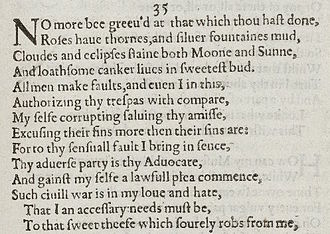Sonnet 35
Q1
Q2
Q3
C
No more be griev’d at that which thou hast done:
Roses have thorns, and silver fountains mud;
Clouds and eclipses stain both moon and sun,
And loathsome canker lives in sweetest bud.
All men make faults, and even I in this,
Authorizing thy trespass with compare,
Myself corrupting, salving thy amiss,
Excusing thy sins more than thy sins are;
For to thy sensual fault I bring in sense—
Thy adverse party is thy advocate—
And ’gainst myself a lawful plea commence:
Such civil war is in my love and hate,
That I an accessary needs must be
To that sweet thief which sourly robs from me.
4
8
12
14
Shakespeare's Sonnet 35 is part of the Fair Youth sequence, commonly agreed to be addressed to a young man; more narrowly, it is part of a sequence running from 33 to 42, in which the speaker considers a sin committed against him by the young man, which the speaker struggles to forgive.
Sonnet 35 is an English or Shakespearean sonnet. The English sonnet has fourteen lines, divided into three quatrains and a final rhyming couplet. It follows the form's rhyme scheme: abab cdcd efef gg, and is written in a type of metre called iambic pentameter based on five pairs of metrically weak/strong syllabic positions. Line four exemplifies a regular iambic pentameter
Two seemingly unmetrical lines can be explained by the Elizabethan pronunciations authórizing (line 6) and áccessary (line 13).
C. Knox Pooler notes that line 4 echoes a simile in The Two Gentlemen of Verona that was derived from Plutarch; Stephen Booth notes several adaptations of proverbs, applied against one another in a manner that tends to reinforce the contradictory emotions of the speaker. Fleay perceived an allusion to Elizabeth in the "moon" of line 3, and to Southampton in the "bud" of line 4.
...
Wikipedia

